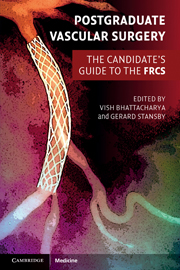Book contents
- Frontmatter
- Contents
- List of contributors
- Preface
- Section 1 Final FRCS vascular clinicals
- Section 2 Final FRCS vascular topics
- 1 Vascular risk factors and their management
- 2 Management of acute limb ischaemia
- 3 Chronic lower limb ischaemia, critical ischaemia and the diabetic foot
- 4 Endovascular and surgical options for peripheral revascularisation
- 5 Abdominal aortic aneurysms
- 6 Thoracic, thoracoabdominal and suprarenal aortic aneurysms
- 7 Aortic dissection
- 8 Popliteal artery aneurysms
- 9 Femoral artery aneurysms
- 10 Carotid, subclavian and vertebral disease
- 11 Diagnosis and management of thoracic outlet syndrome
- 12 Diagnosis and management of hyperhidrosis
- 13 Chronic mesenteric ischaemia
- 14 Acute ischaemic colitis
- 15 Vascular trauma
- 16 Indications and management of lower limb amputation
- 17 Leg swelling and lymphoedema
- 18 Varicose veins and chronic venous insufficiency
- 19 Management of deep vein thrombosis
- 20 Infection in vascular surgery
- 21 Vascular malformations
- 22 Vasospastic disorders and vasculitis
- 23 Critical care considerations and preoperative assessment for general and vascular surgery
- 24 Access surgery
- 25 Basic outline of solid organ transplantation
- Index
- References
25 - Basic outline of solid organ transplantation
- Frontmatter
- Contents
- List of contributors
- Preface
- Section 1 Final FRCS vascular clinicals
- Section 2 Final FRCS vascular topics
- 1 Vascular risk factors and their management
- 2 Management of acute limb ischaemia
- 3 Chronic lower limb ischaemia, critical ischaemia and the diabetic foot
- 4 Endovascular and surgical options for peripheral revascularisation
- 5 Abdominal aortic aneurysms
- 6 Thoracic, thoracoabdominal and suprarenal aortic aneurysms
- 7 Aortic dissection
- 8 Popliteal artery aneurysms
- 9 Femoral artery aneurysms
- 10 Carotid, subclavian and vertebral disease
- 11 Diagnosis and management of thoracic outlet syndrome
- 12 Diagnosis and management of hyperhidrosis
- 13 Chronic mesenteric ischaemia
- 14 Acute ischaemic colitis
- 15 Vascular trauma
- 16 Indications and management of lower limb amputation
- 17 Leg swelling and lymphoedema
- 18 Varicose veins and chronic venous insufficiency
- 19 Management of deep vein thrombosis
- 20 Infection in vascular surgery
- 21 Vascular malformations
- 22 Vasospastic disorders and vasculitis
- 23 Critical care considerations and preoperative assessment for general and vascular surgery
- 24 Access surgery
- 25 Basic outline of solid organ transplantation
- Index
- References
Summary
Key points
Solid organ transplantation is now commonplace and is the standard of care for patients with end-stage organ failure
Indications have changed over time and there are few absolute contraindications
Equity of access to transplant waiting lists is paramount and selecting the correct recipient and donor pair will optimise the outcome
The surgical techniques for all organ transplantation are now well established and standardized and as a result there has been a year-on-year improvement in 1-year survival. Most recipeints die because of co-morbidity or poor organ function
Live donor transplantation for both kidney and liver recipients has become an extremely important source of donor organs
Complications are general to surgical patients but indeed each organ has its own specific risks
Immunosuppression has advanced hugely over the past 10 years and, as a result, the overall attrition rate due to acute rejection has reduced considerably
The biggest problem facing transplantation today is the donor shortage. In 2008, the organ donor taskforce set up by the Minister of Health has set out a plan to increase donation by 50%
Until this happens, transplantation will always have to deal with the ethical dilemmas of allocation, utilization and fairness
Introduction
Solid organ (liver, pancreas and kidney) transplantation is an important treatment modality for end-stage organ failure. Indeed if a vital organ such as the liver fails, transplantation is the only management option currently available.
Organ transplantation increases life expectancy and quality of life (for the recipient and their family), but is not without risk.
- Type
- Chapter
- Information
- Postgraduate Vascular SurgeryThe Candidate's Guide to the FRCS, pp. 298 - 316Publisher: Cambridge University PressPrint publication year: 2011



